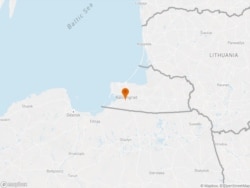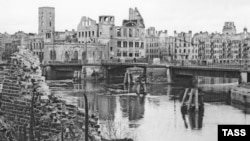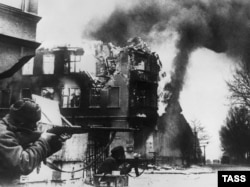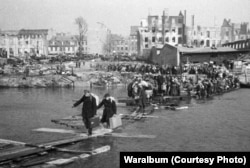KALININGRAD, Russia -- One day in the late 1990s, Maria Taran heard the dog barking out in her yard. She found a strange man standing at the gate, gazing up at her house.
“It turned out he was a German,” the 83-year-old Taran, who has lived in this city on the Baltic Sea since shortly after World War II, told RFE/RL. “He grew up in this house and left when he was just a boy.”
She invited the stranger in and they began to talk. It turned out that the house, which by that time had been divided into two apartments, had been built by a German doctor for his family.
“My heart shivered when he got down on his knees and embraced the old stove,” Taran recalled. “We never could understand the point of the strange room on the upper floor that was isolated from the apartment. He told me that it was a room for a servant.”
Seventy-five years ago, the German city of Koenigsberg and much of the surrounding territory were incorporated into the Soviet Union in the wake of the defeat of Nazi Germany in World War II. In the attic of Taran’s home, there is a brick carved with the date the house was built -- the fatal year of 1939.
When World War II began, Koenigsberg had a population of about 375,000 and was one of Germany’s 10 largest cities. It was a major trading and military center, with thriving Polish, Lithuanian, and Jewish communities. Culturally, it was associated with philosopher Immanuel Kant, mathematician Christian Goldbach (who for several years was tutor to Peter the Great and served in the Russian diplomatic corps), and writer E.T.A. Hoffman (who wrote the novella that served as the basis for Pyotr Tchaikovsky’s ballet The Nutcracker).
When the war ended in 1945, the city was devastated, its historical center razed by British bombing raids in August 1944, and much of the rest destroyed by the Soviet Red Army’s relentless march on Berlin. The population of the city by the end of the fighting had been reduced to less than 65,000.
Nonetheless, even before the war ended, Soviet dictator Josef Stalin had his eye on the region.
“The Russians have no year-round ports on the Baltic Sea,” Stalin argued during the Allied conference in Tehran in 1943. “That is why we need the year-round ports of Koenigsberg and Memel (now the Lithuanian city of Klaipeda) and the surrounding territory of East Prussia.” He added a claim that “historically these are fundamentally Slavic lands.”
The prehistory of the region is disputed, so it is unclear exactly what Stalin had in mind. The city, however, was occupied by the Russian Empire from 1758 until 1762 during the Seven Years War.
The Allies, eager to have Stalin’s assurance that the Soviet Union would enter the war against Japan after Germany’s defeat and ensure an end to German militarism, acceded to the dictator’s demand. The transfer was made formal at the Potsdam Conference on October 17, 1945, when the Allies drew the borders between Poland and the Soviet Union. The new Soviet region was named after the old Bolshevik revolutionary Mikhail Kalinin shortly before he died in June 1946.
It took decades before the Russians in the Kaliningrad region fully stopped thinking of their German neighbors as “fascists.”
The Kaliningrad region’s status as part of the Soviet Union was reaffirmed by the 1975 Helsinki Final Act, and Germany renounced its claim to the region in a 1990 treaty.
Today, Kaliningrad Oblast is Russia’s westernmost region, an exclave slightly larger than the Balkan country of Montenegro that is surrounded by Poland and Lithuania and has a population of about 950,000. Ethnic Germans make up just 0.8 percent of the population.
By the end of the 1940s, more than 100,000 ethnic Germans had been expelled from the region, although in the immediate postwar period the German natives and new settlers from other parts of the Soviet Union lived together uneasily under brutal conditions.
“The city was in ruins,” recalled 95-year-old Khakim Bikhteyev, a Red Army officer who served in the military administration of the city during the last months of the war and the immediate postwar period. “In 1945, empty buildings were taken apart for bricks that were sent to rebuild Leningrad and Stalingrad.”
“It was particularly hard in the countryside,” he added. “Before leaving, the Germans had blown up the dams and flooded the fields. There was hardly anywhere suitable for planting. We went around from house to house, but the Germans had no provisions. We were given ration cards. We had ours and the Germans had theirs. But you don’t get full from ration cards. We were given just enough food to keep us from starving.”
In the first years, most civilians were impressed to do seasonal agricultural work.
Albert Bich, an 83-year-old professor of engineering at the Kaliningrad State Technical University, said he doesn’t remember those times as particularly hard. He had survived the siege of Leningrad and recalled having nothing to eat but sparrows and nettles. As he was being evacuated via the Road of Life across frozen Lake Ladoga, he saw a truckload full of children break through the ice ahead of him, killing everyone on board.
“But our truck made it through, and so I am alive,” he said, adding that his childhood had “hardened” him.
Bich’s aunt participated in the battle for Koenigsberg and remained there after the war. His family decided to join her from their refuge in Siberia.
“When we arrived, I wasn’t afraid of the new city or of the Germans,” he told RFE/RL. “I was more curious. The red-tiled roofs…. We had never seen anything like that. I remember a lot of white lilacs. In the basement of our building, there lived a German woman and her children. In 1946, I saw for the first time how people clean the sidewalks. She took a mop and cleaned the sidewalk in front of the house. I never saw that in Russia.
“People stood in lines for bread,” Bich said. “There was one line for Germans and another for Russians. When the lines approached one another, we would push the German children. I’m ashamed of that now, but we didn’t know what we were doing back then.”
Tamara Bonadyseva, 90, was 16 when she, her parents, four siblings, and a cow that miraculously survived the war made their way to Kaliningrad from the Minsk region in early 1946.
“We went from one collective farm [in Belarus] to another,” she remembered. “At first, we all worked together -- the Germans and our people. We had a windmill that generated electricity, and there was a German whose job was to look after it. In 1948, they were all sent off to Germany.”

It took decades before the Russians in the Kaliningrad region fully stopped thinking of their German neighbors as “fascists.” In the 1980s and '90s, the region welcomed busloads of “nostalgic Germans” who came to see the city that they or their families had left.
“Germans in strange, bright shorts and shapeless jackets fed the local kids during the difficult perestroika years with chewing gum and handed out deutsch marks,” said Maria Taran, the woman who lives in the house built before the war by a German doctor. “Back then, the kids would immediately identify the buses with Germans and let everyone know. German humanitarian aid really helped Kaliningraders back then. The children were all carrying German briefcases and wearing blue jeans.”
Although much of the region’s German heritage has been lost forever, some Russians are working to save the remaining Prussian architectural heritage.
“The losses have been enormous,” Oleg Li, head of the nongovernmental Prussian Cultural Heritage group, told RFE/RL earlier this year. “Taking buildings apart for the bricks is done on a massive scale in the eastern and southern parts of the region, where the economy is bad. In the coastal cities, and especially Kaliningrad, they are just knocked down to make way for new construction.
“The war ended [long ago], but we are still losing things year after year,” he said.













